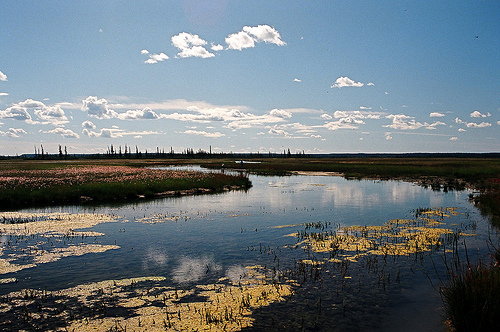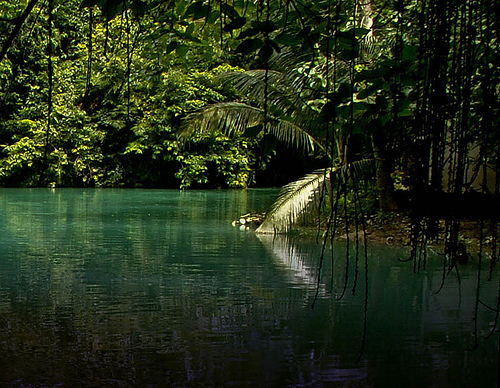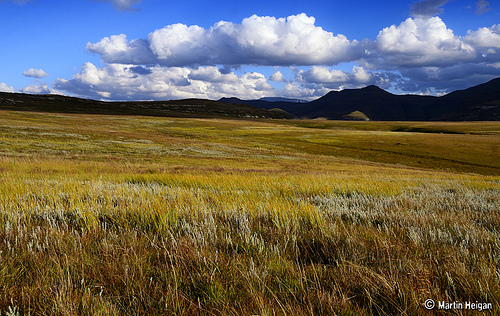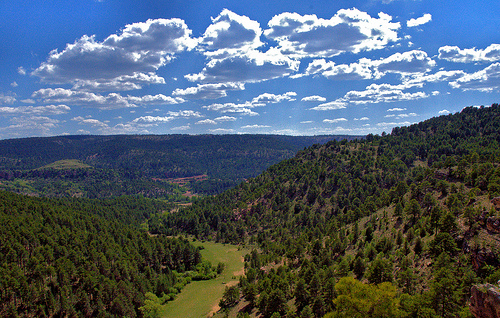The Sax River and the Kaynmian Plain
The Kaynmian Plain is exceedingly fertile, even more so along the banks of its rivers, the longest and greatest being the Sax. Out upon this vast, near-indefensible plain, the Intozan tribes built a few scattered villages. Around these spots of society coalesced the first civilization, held fragilely within seven, little, squabbling cities: Graxdon, Kaynmo, Kranklehbur, Mutraym, Vauzur, Vehrseen, and Veletsax. Over time increasing organization within these cities led to successes in agriculture and crafts, which in turn provoked the envy of the surrounding Intozan tribes, especially the Ultassites.

Plains River subarcticmike via photopin cc
By need and by force, the Seven Cities united to defend themselves. The personality that brought this about was a young king of Kaynmo named Ehrquaun. His father Resnaun had annexed Graxdon through marriage. Ehrquaun found among the men of Graxdon a curious new hunting weapon, the bow and arrow, and adapted it for military use. Building on this small piece of unity and this advance in war technology, Ehrquaun swept through the five remaining Seven Cities, which all had been weakened by years of war. Ehrquaun then turned against the Ultassites and baited them into an ambush that is now legendary in military history. Once the Ultassites were defeated, Ehrquaun united his area of the Kaynmian Plain into the Tykolm’s first real nation.
By Ehrquaun’s time, the written word had already been long established in the form of hieroglyphics among the Seven Cities. Military unity brought systemized communication, increased trade, and a flowering of the Kaynmian culture. This First Kaynmian Union, called Saxolm (realm of the Sax), lasted over two centuries.
Saxolm eventually fell into civil war and disunity for a time. Then in a surprise victory over the allied forces of four cities, Trohneest of Veletsax began that city-state’s rise into a Second Kaynmian Union called Veletolm. Trohneest’s son Thaylinaun, a brilliant military strategist, expanded east to the Rood Valley, west into the Ultass Valley, and south past Vehrseen.
But before 200 years were complete, Veletolm had disintegrated into four separate kingdoms: Graxolm, Lower Saxolm, Roodolm, and Upper Saxolm. The four kingdoms vied for over a century to reestablish union but without success, that is, until Orakan came to the throne of Lower Saxolm. Though Thaylinaun had used military prowess to build his kingdom, Orakan used diplomacy to transform a few minor victories – all unremarkable except in political context – into the Third Kaynmian Union of Kaynmolm. He shared power with regional leaders by giving them semi-autonomy in return for allegiance. At first these leaders were governors, but governors soon became dukes, and eventually the nation had several enclaves of wealth and power.
This arrangement between kingdom and duchies worked for over eighteen centuries. Yet the weaknesses inherent in that system and the increasingly factional denominationalism of Kellism, the Kaynmian religion, conspired against the kingdom’s unity, and Kaynmolm became ripe for its devastating fall to the Chirannese at the end of the Ancient Era.
The Great Bend of the Keedo River and the Laydran Rainforest
From its emergence out of the Esseds, through the rainforest, and on to its convergence with the Chirann River, the Keedo River is shaped as a long loop. Deep in the rainforest around the Keedo, the Layite clans settled into estates for the purpose of orcharding, herding, and protection. At the top of the Keedo’s Great Bend resided Clan Vindra in its village of Inryd Vindra, soon known as Vindalohn. At Vindalohn, Clan Vindra built the first mexpauna, or temple-observatory. And here the mexpauna’s priests modified crude Laydran pictographs into the first alphabet.

Rainforest River Storm Crypt via photopin cc
Though astrology and alphabet might be unifying motivations, neither these nor war succeeded in gathering the Layites into a kingdom for Clan Vindra. The final joining of the clans into a nation came from an unlikely source. Sevalork, the chief of Clan Leedril, discovered he had a strong claim to the Vindran inheritance. After exploiting this claim, he combined the strength of Leedril, Vindra, and the clans already under the sway of these two into a gravity that drew in the remaining clans. The Laydrans knew Sevalork ceremonially as Shapajohd, or Deliverer, and named him as their first king. To unite the clans into the nation Laydrehkolm, Shapajohd used inspiration and patriotism more than conquests. With a new stability, Laydran civilization took hold and expanded. Their calendar was unsurpassed in the ancient world; their economy flourished; their military became exceedingly effective. For over 2000 years, Laydrehkolm was a near unassailable power.
Laydran history during the Ancient Era would have been an unbroken peaceful stretch save for the Plohbite Invasion, which brought about the complete collapse of the nation. The Plohbite Wars were long and arduous, but within six years of Laydrehkolm’s fall, Tryvenlork, the last remaining royal heir at that time, was able to reestablish his kingdom’s independence and secure her borders. This fall and rebirth divide ancient Laydran history into a Long Kingdom Period of nineteen centuries and a Short Kingdom Period. Three hundred years after breaking the Plohbite yoke, Laydrehkolm faced a graver threat: Chirann. From this threat the nation did not recover. But Laydran thought had already imbedded itself deep enough into the psyche of civilized man that it endured the subjugation of the Chirannese Empire and flourished in the newly planted Tulehran Culture.
The Eenax River and the Vayveean Savannah
The Eenax River cutting across the vast Vayveean Savannah makes an efficient route of transportation and trade in this agriculturally plentiful area. The tribes of the savannah dotted the savannah with trading posts, and small cities arose from these. Savannah tradesmen developed a crude logography of their own, but trade with the Kaynmians introduced Kaynmian hieroglyphics. The tribes abandoned their own fledgling writing and modified Kaynmian hieroglyphs for their own use, making a combined but unique script in the form of Theeran hieroglyphics.

Big Savannah Martin_Heigan via photopin cc
For near 400 years, three primordial kingdoms dominated the savannah. The city of Vohs held sway along the Eenax where it drops from the Esseds into the foothills. Leagues away, the city of Theer controlled the mouth of the Eenax. And to the west of the savannah, the large, peaceable kingdom of Varna had settled the Varn Valley. For centuries, Vohs and Theer warred across the savannah that stood between them. Eventually the small cities of Metross and Ar united in a royal marriage and led the savannah tribes to throw off their oppressors.
Metross on the banks of Lake Eenax became the capital of the newly created kingdom of Vayveea. After conquering Theer and Vohs, Vayveea rapid expanded into an empire soon encompassing all the Near Tooran tribes of Arquisans, Plethans, Chelnans, and even the Varnites. Panicked by the Vayveean juggernaut, the two Bithroan tribal kingdoms hastily put aside their differences and merged into the primitive nation of Idree-idree thereby checking any further western expansion by Vayveea.
The Vayveeans took up and continued the previous cultural development of Theer and Vohs. Like their previous subjugators, the Vayveeans were keenly interested in wealth. They settled and tamed all lands within their borders and enslaved their poor. They built seven great Treasure Cities where taxes were paid, supplies stored, and trade regulated. They continued a sometimes-conflict with Idree-idree, but dared not engage their eastern neighbor, the powerful Kaynmolm.
This state of affairs remained unaltered until an opportunity presented itself in the form of the ravenous nation of Chirann. Approached by Chirannese ambassadors, the Vayveean government worked out a clandestine treaty to divide Kaynmolm. They would forsake their peace with Kaynmolm and invade from the Kaynmian west once Chirann had secured the Rood Valley in the east. Kaynmolm was unable to manage two fronts simultaneously. Kaynmolm fell and Vayveea gained a great swath of Kaynmian lands. Vayveea exited the Ancient Era rich in all matter of wealth and power. Yet this increase only exacerbated the moral corruption of the nation, a corruption that plagued Vayveea for millennia and sapped its cultural greatness.
The Andeean Plateau overlooking the Confluence of the Menlond and Dyeez Rivers
Far to the north and east of the other three cradles lies the vast Welts Expanse, a land of rolling hills, open forests, and definitive seasons. Upon the Expanse, a fourth and wholly unique civilization developed. The tribes here were traditionally nomadic. However, the chief of a humble Tynohstite clan grew tired of his wanderings. This almost-mythic figure, Andeea, built a home atop the plateau overlooking where the Dyneez River joins the Menlond River. The city he founded there, named Hafila Andeea, became the core of a civilization that spread like a virus via trade up and down these two rivers and across the Ranzo Plain, which lies behind the Andeean Plateau. Several city-states spawned, some modest and some remarkable. Wavering between war and commerce, the states resisted conquest for a few generations until the army of Darus-Daynin began to shake up the status quo. But that is a story of another era.

Plateau & River druidabruxux via photopin cc

